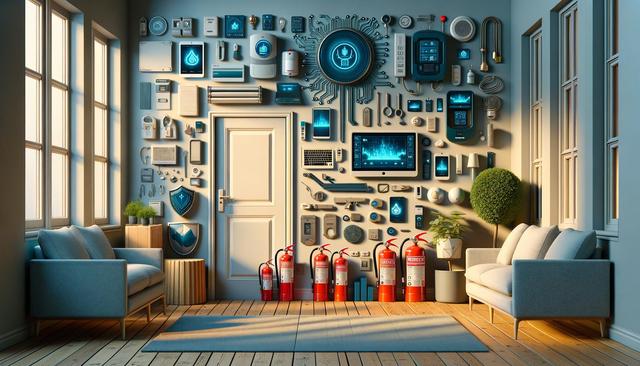
Safety Features Worth the Upgrade: A Smarter Investment in Protection
Why Modern Safety Features Matter More Than Ever
Technological advancements in personal and public safety have significantly evolved over the past decade. While many older models of vehicles, appliances, and devices offer basic safety features, newer upgrades provide improved precision, automation, and responsiveness. Investing in these modern enhancements can lead to fewer accidents, reduced injury severity, and even long-term savings on insurance premiums or repair costs.
One key reason to consider upgrading is the growing complexity of modern environments. Whether it’s on the road, at home, or in the workplace, hazards are not always predictable. Up-to-date safety features are designed to detect and respond to these challenges faster than human reaction alone. For example, newer vehicles now come with systems that monitor blind spots or automatically apply brakes when an obstacle is detected—features that weren’t standard a few years ago.
Incorporating modern safety technology is not only about convenience; it’s about enhancing your ability to avoid danger proactively. As these systems become more widely available, skipping out on them could mean missing essential protections that are rapidly becoming standard in many sectors.
Upgrade Options in Automotive Safety
Among the most impactful areas where safety upgrades show immediate value is in the automotive industry. Vehicles today come equipped with a range of features that make driving safer for everyone on the road. These systems use sensors, cameras, and radar to assist the driver and prevent potential collisions.
Some noteworthy upgrades worth considering include:
- Lane departure warning and lane keeping assist
- Adaptive cruise control
- Automatic emergency braking
- Cross-traffic alert systems
Each of these features works by analyzing real-time data and either alerting the driver or taking corrective action to avoid accidents. While they may add to the initial purchase cost, the benefits in terms of safety and reduced crash likelihood are well-documented. Additionally, these upgrades can contribute to lower insurance rates and higher resale value, making them a financially sound choice as well.
Many of these features are now available even in entry-level models or can be added as part of optional safety packages. The key is to evaluate your specific needs and driving habits when determining which upgrades will offer the most value for you.
Home Safety Technology: More Than Just Alarms
Home safety has seen a wave of innovation in recent years. Beyond traditional smoke detectors and burglar alarms, smart home systems now offer comprehensive monitoring and control options that enhance both security and convenience. These systems help homeowners stay aware of potential issues whether they’re at home or away.
Some valuable home safety upgrades include:
- Smart smoke and carbon monoxide detectors
- Video doorbells with motion detection
- Remote-controlled lighting and window shades
- Water leak sensors and automatic shutoff valves
These technologies offer real-time alerts and automated responses that can prevent emergencies from escalating. For instance, a smart water sensor can detect a leak and shut off the main water supply before significant damage occurs. Similarly, smart smoke detectors can send alerts to your phone even when you’re not home, allowing you to take action immediately.
By integrating these features into a unified system, users gain greater control and situational awareness. As a result, the home becomes not just a place of comfort, but also a safer environment for all occupants.
Workplace Safety Enhancements Worth Considering
In the workplace, safety upgrades help protect employees while also ensuring compliance with regulations and improving overall productivity. Whether in an office or an industrial setting, enhanced safety features reduce the risk of injuries and support a healthier working environment.
Some effective workplace safety upgrades include:
- Automated emergency lighting and fire suppression systems
- Wearable safety monitors for hazardous environments
- Touchless access control systems
- Real-time air quality monitoring tools
These systems not only provide real-time data but also help in preventive maintenance and emergency response. For instance, air quality monitors can detect harmful gases before they reach dangerous levels, enabling swift evacuation or ventilation.
Investing in safety technology for the workplace demonstrates a commitment to employee welfare, which can improve morale and reduce turnover. It also positions businesses as forward-thinking and responsible—qualities that clients and partners increasingly value in today’s competitive market.
Cost vs. Benefit: Making the Right Choice
One common hesitation when considering safety upgrades is the cost. However, when analyzed from a long-term perspective, many of these features provide substantial returns. Reduced risk of injury, fewer accidents, and lower repair or hospital bills can all offset the initial investment.
When deciding which upgrades are right for you, consider:
- The specific risks you face in your environment (e.g., high-traffic areas, remote locations, young children, etc.)
- How often the safety features would be used or triggered
- Whether insurance providers offer discounts for certain safety features
- The potential resale value of upgraded vehicles, homes, or equipment
Furthermore, many manufacturers now bundle safety upgrades in packages, making them more affordable when purchased together. It’s also worth exploring financing or rebate programs that may be available through local governments or insurance companies for specific upgrades like smoke detectors or vehicle safety systems.
Ultimately, the decision to invest in safety features should be viewed as a proactive step toward reducing potential harm and increasing overall confidence in your surroundings.